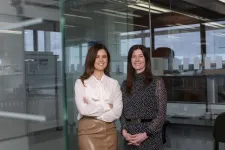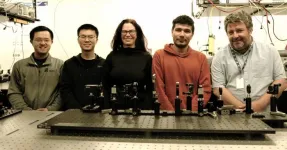(Press-News.org) Research that involves implanting devices into the brains of human volunteers creates a special moral obligation that extends beyond the trial period—an obligation that researchers, device manufacturers, and funders owe to the volunteers. This is the conclusion of two new essays in the Hastings Center Report that launch a series on the ethical and social issues raised by brain research.
The “Neuroscience and Society” series is supported by the Dana Foundation and will be published in open-access format online over the next three years.
The series seeks to promote deliberative public engagement about neuroscience, writes Hastings Center senior research scholar Gregory E. Kaebnick, who leads the development of the series, in “Neuroscience and Society: Supporting and Unsettling Public Engagement,” the introductory essay. “The ultimate goal of the Neuroscience and Society series is to contribute to a vitally important but somewhat uncertain political project often called ‘alignment.’ The guiding thought in that project is that science should align with the public’s values; it should take society in a direction that’s good for society, as judged by society.”
Following the introduction, two essays discuss post-trial ethical obligations raised by studies with cutting-edge neural devices that have a range of potential benefits, such as deep brain stimulation to alleviate psychiatric conditions and brain-computer interfaces to aid communication.
Brain Pioneers and Moral Entanglement: An Argument for Post-trial Responsibilities in Neural-Device Trials
Sara Goering, Andrew I. Brown, and Eran Klein
Human participants in neural-device trials are “brain pioneers,” entrusting researchers with access to their brains. For many of these researchers, what should happen at the end of the study is a troubling question without a clear answer. “Researchers and funders of neural-device trials owe something to participants that, we insist, exceeds the usual benefits of participating,” write the authors. In many cases, “it includes ensuring participants’ continued access to neural devices.”
Identity Theft, Deep Brain Stimulation, and the Primacy of Post-trial Obligations
Joseph J. Fins, Amanda R. Merner, Megan S. Wright, and Gabriel Lázaro-Muñoz
“When neuroethicists write about deep brain stimulation (DBS) via implanted neural devices, they sometimes resort to science fiction hyperbole—imagining parables of cyborgs whose identities are hijacked by the technology,” the essay begins. “This is because with the implantation of such technology comes the threat of a loss of personal identity, that sense of self that is felt as unique to a person.” But findings from two deep brain stimulation trials for traumatic brain injury and obsessive-compulsive disorder reveal that injury and illness rob individuals of personal identity and that neuromodulation can restore it. “The early success of these interventions makes a compelling case for continued post-trial access to these technologies.”
The series is developed with support from Hastings Center senior research scholar Erik Parens. and the guidance of a steering committee of six scholars:
Jennifer Chandler, University of Ottawa
Winston Chiong, University of California San Francisco
Joseph J. Fins, Weill Cornell Medical School
Sara Goering, University of Washington
Jonathan D. Moreno, University of Pennsylvania
Oliver Rollins, University of Washington
For more information, contact:
Susan Gilbert
Director of Communications
The Hastings Center
gilberts@thehastingscenter.org
845-424-4040 x244
END
Neuroscience and Society Series: aligning science with the public’s values
What is owed the “brain pioneers?” What is good for society?
2024-03-25
ELSE PRESS RELEASES FROM THIS DATE:
Friend or foe: A closer look at the role of health care algorithms in racial and ethnic disparities
2024-03-25
PHILADELPHIA -- For years, it was harder for Black patients to secure a coveted spot on the national kidney transplant waitlist because a clinical algorithm was making Black patients appear healthier than they were. After a Penn Medicine researcher exposed the problem in 2019—and showed how it exacerbated racial disparities in kidney disease—a national taskforce recommended removing race from the algorithm’s scoring, a move that has quickly been adopted throughout the country in an effort to reduce ...
ABT199/Venetoclax synergism with thiotepa in acute myeloid leukemia (AML) cells
2024-03-25
“[...] the combination of ABT199/venetoclax and Thio enhances the cytotoxicity of (Flu+Clad+Bu) in AML cell lines and leukemia patient-derived cell samples.”
BUFFALO, NY- March 25, 2024 – A new research paper was published in Oncotarget's Volume 15 on March 14, 2024, entitled, “ABT199/venetoclax synergism with thiotepa enhances the cytotoxicity of fludarabine, cladribine and busulfan in AML cells.”
ABT199/venetoclax, an inhibitor of the pro-survival BCL-2 protein, has improved AML treatment. Its efficacy in hematopoietic ...
More exposure to artificial, bright, outdoor nighttime light linked to higher stroke risk
2024-03-25
Research Highlights:
A large study of residents in Ningbo, China, a major city of more than 8.2 million residents, found that exposure to more artificial, outdoor, nighttime light was associated with a higher risk of conditions that affect brain health.
Excessive exposure to air pollution and artificial, bright light at night were both independently linked to a higher risk of developing cerebrovascular disease and having a stroke.
Embargoed until 1 p.m. CT/2 p.m. ET, Monday, March 25, 2024
DALLAS, March 25, 2024 — People continuously ...
AACR: Progress treating pancreatic cancer, immunotherapy for head and neck cancers, potential biomarker for aggressive neuroendocrine carcinomas and more
2024-03-25
Investigators from the UCLA Health Jonsson Comprehensive Cancer Center will discuss the latest breakthroughs and cutting-edge science at the annual meeting of the American Association for Cancer Research (AACR), which attracts more than 20,000 oncology professionals from around the world.
The annual meeting will feature more than 40 regular, late-breaking and clinical trial abstracts from UCLA physicians and scientists, who will present their latest work in key areas of translational and basic scientific ...
Insights from patient who cleared hepatitis C could lead to vaccine
2024-03-25
ITHACA, N.Y. -- By studying individuals who spontaneously clear hepatitis C infections, a team of researchers has identified viable vaccine targets for a disease that infects 70 million worldwide with case numbers increasing every year.
It turns out that a quarter of people who become infected with the hepatitis C virus clear the infection on their own without treatment, while the remaining three-quarters of people develop chronic infections that can last for years. The blood-borne disease – which causes liver cirrhosis, liver ...
Uncovering the mystery of Dorset’s Cerne Giant
2024-03-25
For centuries, the Cerne Giant, a figure carved into a hillside in Dorset depicting a nude man carrying a club and stretching some 180 feet high, has fascinated locals and visitors to the area. The history of the giant, however, and in particular, its age, has long been a mystery. A new paper in Speculum: A Journal of Medieval Studies proposes that the Cerne Giant can in fact be dated to the early Middle Ages, and, as a result, its cultural context and significance more clearly understood.
“The Cerne Giant in its Early Medieval Context,” by authors Thomas Morcom and Helen Gittos, acknowledges that previous attempts to date the giant placed ...
RCSI research identifies promising drug combination for multiple myeloma treatment
2024-03-25
25 March 2024: RCSI research has found that venetoclax, a medication currently approved for leukaemia, has benefits for patients with multiple myeloma when used in combination with another drug. This discovery offers a new avenue of treatment options for the currently incurable disease.
Multiple myeloma (MM) is a type of blood cancer that is newly diagnosed in around 400 people in Ireland each year. Despite treatment advances in recent years, it remains incurable. The search for innovative treatment strategies is crucial, particularly for patients whose cancer is resistant to standard care.
In the new study published in Haematologica, researchers at the RCSI Department of ...
Confusing assistance requirements contribute to food insecurity among college students
2024-03-25
Philadelphia, March 25, 2024 – Food insecurity among college students is associated with negative physical and mental health and lower academic performance and graduation rates. A recent research study in the Journal of Nutrition Education and Behavior, published by Elsevier, investigates why over half of college students eligible for the Supplemental Nutrition Assistance Program (SNAP)—the nation’s largest food assistance program—do not apply.
Lead study author Suzanna M. Martinez, PhD, MS, Department of Epidemiology and Biostatistics, University of California San Francisco, explained, “In California, ...
Pushing back the limits of optical imaging by processing trillions of frames per second
2024-03-25
Professor Jinyang Liang’s team is advancing in imaging speed with a new ultrafast camera system.
Pushing for a higher speed isn’t just for athletes. Researchers, too, can achieve such feats with their discoveries. This is the case for Jinyang Liang, Professor at the Institut national de la recherche scientifique (INRS), and his team, whose research results have recently been published in Nature Communications.
The group based at INRS’ Énergie Matériaux Télécommunications Research Centre has developed a new ultrafast camera system that can capture up to 156.3 trillion ...
Patient recovery after surgery for esophageal cancer isn’t influenced by using standard or keyhole incisions
2024-03-25
New research has found no evidence of a difference between recovery time and complications when comparing standard and keyhole surgical incisions for the treatment of oesophageal cancer (cancer of the gullet). The study, led by the University of Bristol Medical School and published in the British Journal of Surgery, showed surgeons treating patients with oesophageal cancer do not need to change their practice if they have a strong preference for either procedure type.
Oesophageal cancer is the tenth most common cancer globally. It causes one in 18 cancer-related deaths. ...
LAST 30 PRESS RELEASES:
Injectable breast ‘implant’ offers alternative to traditional surgeries
Neuroscientists devise formulas to measure multilingualism
New prostate cancer trial seeks to reduce toxicity without sacrificing efficacy
Geometry shapes life
A CRISPR screen reveals many previously unrecognized genes required for brain development and a new neurodevelopmental disorder
Hot flush treatment has anti-breast cancer activity, study finds
Securing AI systems against growing cybersecurity threats
Longest observation of an active solar region
Why nail-biting, procrastination and other self-sabotaging behaviors are rooted in survival instincts
Regional variations in mechanical properties of porcine leptomeninges
Artificial empathy in therapy and healthcare: advancements in interpersonal interaction technologies
Why some brains switch gears more efficiently than others
UVA’s Jundong Li wins ICDM’S 2025 Tao Li Award for data mining, machine learning
UVA’s low-power, high-performance computer power player Mircea Stan earns National Academy of Inventors fellowship
Not playing by the rules: USU researcher explores filamentous algae dynamics in rivers
Do our body clocks influence our risk of dementia?
Anthropologists offer new evidence of bipedalism in long-debated fossil discovery
Safer receipt paper from wood
Dosage-sensitive genes suggest no whole-genome duplications in ancestral angiosperm
First ancient human herpesvirus genomes document their deep history with humans
Why Some Bacteria Survive Antibiotics and How to Stop Them - New study reveals that bacteria can survive antibiotic treatment through two fundamentally different “shutdown modes”
UCLA study links scar healing to dangerous placenta condition
CHANGE-seq-BE finds off-target changes in the genome from base editors
The Journal of Nuclear Medicine Ahead-of-Print Tip Sheet: January 2, 2026
Delayed or absent first dose of measles, mumps, and rubella vaccination
Trends in US preterm birth rates by household income and race and ethnicity
Study identifies potential biomarker linked to progression and brain inflammation in multiple sclerosis
Many mothers in Norway do not show up for postnatal check-ups
Researchers want to find out why quick clay is so unstable
Superradiant spins show teamwork at the quantum scale
[Press-News.org] Neuroscience and Society Series: aligning science with the public’s valuesWhat is owed the “brain pioneers?” What is good for society?


